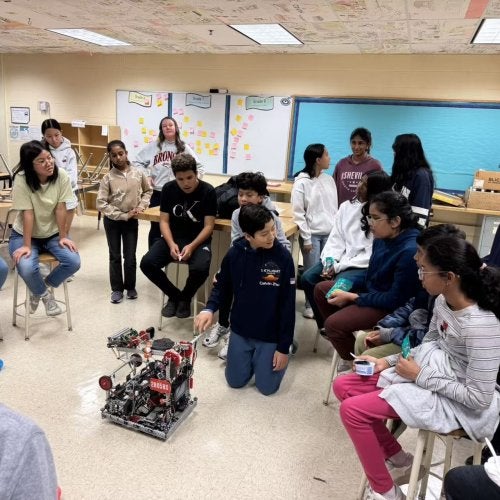

Grit: More Questions than Answers Regarding its Meaning and How it Relates to STEM Achievement

Some ideas and constructs in psychology and education catch hold and become popular phenomenon before enough research has been done to figure out clearly what the construct is and what it relates to. More than 10 years ago, Angela Duckworth, a professor at the University of Pennsylvania, and her colleagues introduced the construct “grit” into the psychological literature. They defined grit as a personality characteristic reflecting individuals’ passion and perseverance for achieving long-term goals. Professor Duckworth stated that grit relates to the well-established personality characteristic conscientiousness (defined as being organized, planful, and hard-working), but differs from it because of its focus on long-term achievement and maintaining one’s interests over time.
Grit quickly began receiving attention not only in the research literature but also the popular press and in educational policy circles. Professor Duckworth appeared in several TED Talks, where she described the importance of grit for succeeding in different activities, particularly challenging endeavors that took much time and effort. She and reporter Paul Tough each wrote bestselling books touting the virtues of grit. The Institute for Educational Sciences, a branch of the U.S. Department of Education, promoted interventions to improve students’ grit as a way to improve their achievement and effort in school. And the developers of the college entrance exam the ACT considered adding items assessing students’ grit to it. Yet, all of this occurred before researchers had thoroughly ‘vetted’ grit or learned whether it relates to important achievement outcomes such as grades, test scores, degree completion, said COE Professor Emeritus Allan Wigfield.
Over the last few years, however, researchers have begun to do just that. One of those studies is being conducted by researchers, including Dr. Wigfield, at the UMD College of Education.
Dr. Wigfield and Associate Professor Ji Seung Yang, both in the Department of Human Development and Quantitative Methodology, are leading a study that is examining grit in different age groups and different cultures, as well as how strongly it relates to students’ achievement in STEM courses in high school and college. The study includes nearly 1,250 high school and 600 college students from the United States and 600 college students from Korea. They received a grant of $1.24 million dollars over four years from the National Science Foundation to support the work.
Professor Wigfield, Associate Professor Yang, and their team have two new articles based on data from the project. In the first, published in 2020 in the Journal of Educational Psychology (Morell, Yang, Gladstone, Faust, Ponnock, Lim, and Wigfield, 2020), the research team used statistical techniques to investigate how similar or different grit is in high school and college students and in two different cultures (South Korea and the U.S). There are only a few published studies looking at age differences and cultural differences in grit.
“We were quite interested in an Eastern culture, and how they might view grit and whether they understand it in the same way that people in the U.S. do,” Professor Emeritus Wigfield said, as to the selection of South Korea for the study.
The researchers report three main findings. First, there are both age and cultural differences in how study participants responded to Professor Duckworth’s grit measure, as well as in the “structure” of the construct. This means that high school and college students, and U.S. and Korean college students, understand the meaning of grit differently. Second, as stated earlier, Professor Duckworth and her colleagues proposed that there are two aspect or parts of grit, perseverance of effort (PE) and consistency of interests (CI). They stated both should relate to different outcomes. The UMD research team found that PE was the only aspect of grit that related to students’ grades. Finally, the team found that although Professor Duckworth and colleagues defined grit as something important for achieving long-term goals, the items on her measure did not clearly indicate what is meant by “long-term.”
The COE team developed a new measure of grit that quantified long-term as six months; the time period of six months was selected because there were studying older adolescents. They found that their new measure differed less across age and culture than did Professor Duckworth’s measure.
In a study published in 2020 in the Journal of Research in Personality, the team (Ponnock, Muenks, Morell, Yang, Gladstone, and Wigfield, 2020) showed that grit and conscientiousness overlapped nearly completely. That is, there is little merit in considering grit as a new and different construct in the personality literature, as Professor Duckworth has claimed it is. Instead, at least as currently measured, it is the same as conscientiousness.
The researchers drew the following two conclusions from these new papers. First, in the Journal of Educational Psychology article, they stated: “Calls to intervene to improve students’ overall grit as a way to enhance their achievement are at best premature and at worst a mistake given our findings and those of others”. In the Journal of Research in Personality article they stated, “We propose that either new measures of grit be developed and validated that justify its treatment as a unique construct, or that researchers should stop examining grit and continue to explore conscientiousness in relation to different aspects of achievement,” and recommended the latter as the better approach.
“Grit is ‘a cautionary tale’ that needs more research,” Dr. Wigfield said. “The grit measures need to be completely revamped if people are going to keep examining it.”
Dr. Wigfield is professor emeritus in the Department of Human Development and Quantitative Methodology, and has research interests in achievement motivation as well as development and socialization of motivation.
Dr. Ji Seung Yang is an associate professer in HDQM. Her research interests and expertise multidimensional/multilevel item response theory, development and validation of measures, estimation and computation algorithms, measurement error and reliability, Generalizability Theory.
Their research on grit is supported by grant 1534846 from the National Science Foundation.


